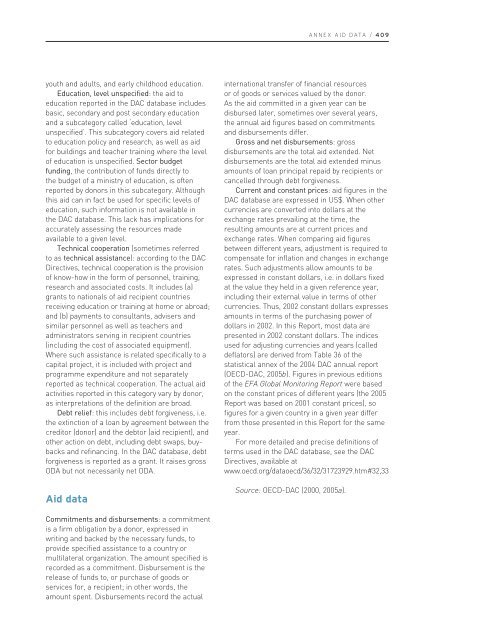literacy for life; EFA global monitoring report, 2006 - Institut de ...
literacy for life; EFA global monitoring report, 2006 - Institut de ...
literacy for life; EFA global monitoring report, 2006 - Institut de ...
Create successful ePaper yourself
Turn your PDF publications into a flip-book with our unique Google optimized e-Paper software.
ANNEX AID DATA / 409<br />
youth and adults, and early childhood education.<br />
Education, level unspecified: the aid to<br />
education <strong>report</strong>ed in the DAC database inclu<strong>de</strong>s<br />
basic, secondary and post secondary education<br />
and a subcategory called ‘education, level<br />
unspecified’. This subcategory covers aid related<br />
to education policy and research, as well as aid<br />
<strong>for</strong> buildings and teacher training where the level<br />
of education is unspecified. Sector budget<br />
funding, the contribution of funds directly to<br />
the budget of a ministry of education, is often<br />
<strong>report</strong>ed by donors in this subcategory. Although<br />
this aid can in fact be used <strong>for</strong> specific levels of<br />
education, such in<strong>for</strong>mation is not available in<br />
the DAC database. This lack has implications <strong>for</strong><br />
accurately assessing the resources ma<strong>de</strong><br />
available to a given level.<br />
Technical cooperation (sometimes referred<br />
to as technical assistance): according to the DAC<br />
Directives, technical cooperation is the provision<br />
of know-how in the <strong>for</strong>m of personnel, training,<br />
research and associated costs. It inclu<strong>de</strong>s (a)<br />
grants to nationals of aid recipient countries<br />
receiving education or training at home or abroad;<br />
and (b) payments to consultants, advisers and<br />
similar personnel as well as teachers and<br />
administrators serving in recipient countries<br />
(including the cost of associated equipment).<br />
Where such assistance is related specifically to a<br />
capital project, it is inclu<strong>de</strong>d with project and<br />
programme expenditure and not separately<br />
<strong>report</strong>ed as technical cooperation. The actual aid<br />
activities <strong>report</strong>ed in this category vary by donor,<br />
as interpretations of the <strong>de</strong>finition are broad.<br />
Debt relief: this inclu<strong>de</strong>s <strong>de</strong>bt <strong>for</strong>giveness, i.e.<br />
the extinction of a loan by agreement between the<br />
creditor (donor) and the <strong>de</strong>btor (aid recipient), and<br />
other action on <strong>de</strong>bt, including <strong>de</strong>bt swaps, buybacks<br />
and refinancing. In the DAC database, <strong>de</strong>bt<br />
<strong>for</strong>giveness is <strong>report</strong>ed as a grant. It raises gross<br />
ODA but not necessarily net ODA.<br />
Aid data<br />
international transfer of financial resources<br />
or of goods or services valued by the donor.<br />
As the aid committed in a given year can be<br />
disbursed later, sometimes over several years,<br />
the annual aid figures based on commitments<br />
and disbursements differ.<br />
Gross and net disbursements: gross<br />
disbursements are the total aid exten<strong>de</strong>d. Net<br />
disbursements are the total aid exten<strong>de</strong>d minus<br />
amounts of loan principal repaid by recipients or<br />
cancelled through <strong>de</strong>bt <strong>for</strong>giveness.<br />
Current and constant prices: aid figures in the<br />
DAC database are expressed in US$. When other<br />
currencies are converted into dollars at the<br />
exchange rates prevailing at the time, the<br />
resulting amounts are at current prices and<br />
exchange rates. When comparing aid figures<br />
between different years, adjustment is required to<br />
compensate <strong>for</strong> inflation and changes in exchange<br />
rates. Such adjustments allow amounts to be<br />
expressed in constant dollars, i.e. in dollars fixed<br />
at the value they held in a given reference year,<br />
including their external value in terms of other<br />
currencies. Thus, 2002 constant dollars expresses<br />
amounts in terms of the purchasing power of<br />
dollars in 2002. In this Report, most data are<br />
presented in 2002 constant dollars. The indices<br />
used <strong>for</strong> adjusting currencies and years (called<br />
<strong>de</strong>flators) are <strong>de</strong>rived from Table 36 of the<br />
statistical annex of the 2004 DAC annual <strong>report</strong><br />
(OECD-DAC, 2005b). Figures in previous editions<br />
of the <strong>EFA</strong> Global Monitoring Report were based<br />
on the constant prices of different years (the 2005<br />
Report was based on 2001 constant prices), so<br />
figures <strong>for</strong> a given country in a given year differ<br />
from those presented in this Report <strong>for</strong> the same<br />
year.<br />
For more <strong>de</strong>tailed and precise <strong>de</strong>finitions of<br />
terms used in the DAC database, see the DAC<br />
Directives, available at<br />
www.oecd.org/dataoecd/36/32/31723929.htm#32,33<br />
Source: OECD-DAC (2000, 2005a).<br />
Commitments and disbursements: a commitment<br />
is a firm obligation by a donor, expressed in<br />
writing and backed by the necessary funds, to<br />
provi<strong>de</strong> specified assistance to a country or<br />
multilateral organization. The amount specified is<br />
recor<strong>de</strong>d as a commitment. Disbursement is the<br />
release of funds to, or purchase of goods or<br />
services <strong>for</strong>, a recipient; in other words, the<br />
amount spent. Disbursements record the actual

















